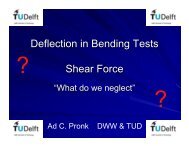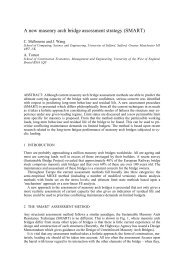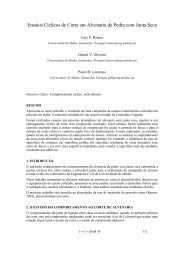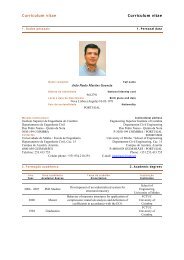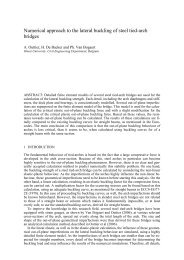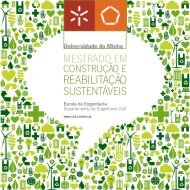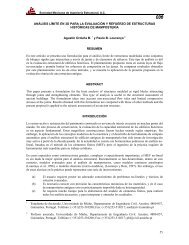Sustainable Construction A Life Cycle Approach in Engineering
Sustainable Construction A Life Cycle Approach in Engineering
Sustainable Construction A Life Cycle Approach in Engineering
You also want an ePaper? Increase the reach of your titles
YUMPU automatically turns print PDFs into web optimized ePapers that Google loves.
• When subjected to high concentration of chloride ions (sea water) and elevated temperatures,<br />
localized severe corrosion known as pitt<strong>in</strong>g corrosion can occur. Besides, stress<br />
corrosion crack<strong>in</strong>g is a severe form of sta<strong>in</strong>less steel corrosion that appears under tensile<br />
stress (service loads or residual stresses) and corrosive environments. But this<br />
mode of corrosion applies only to austenitic sta<strong>in</strong>less steels and depends on the nickel<br />
content.<br />
3.2 The 304, 316 and 430 grades<br />
Table 2. 304, 316 and 430 sta<strong>in</strong>less steel grades ma<strong>in</strong> mechanical properties.<br />
304 316 430<br />
Ultimate strength (MPa) 520 520 450<br />
Yield strength (MPa) 210 220 205<br />
Maximum elongation (%) 45 40 22<br />
Modulus of elasticity (GPa) 200 200 200<br />
Austenitic type 304 (namely 1.4301 <strong>in</strong> euronorm, 18/8: 18% chromium and 8% nickel) has excellent<br />
corrosion and is highly ductile which makes it used for s<strong>in</strong>ks and saucepans. This grade<br />
is usually available <strong>in</strong> the follow<strong>in</strong>g forms: sheet, plate, welded mesh, bar, pipe, decorative tube<br />
etc. The 316 type (1.4401), conta<strong>in</strong><strong>in</strong>g an addition of molybdenum, has improved corrosion resistance.<br />
It is usually regarded as the mar<strong>in</strong>e grade. This grade is nevertheless prone to pitt<strong>in</strong>g<br />
and crevice corrosion <strong>in</strong> warm chloride environments and subject to stress corrosion crack<strong>in</strong>g<br />
above 60°C. High chromium content ferritic grade 430 (1.4016) comb<strong>in</strong>es <strong>in</strong>termediate (good)<br />
corrosion resistance with good formability and ductility. The corrosion resistance is optimal if<br />
the surface is highly polished. It can be obta<strong>in</strong>ed as bright annealed, polished sheet, square, rectangular<br />
and round tubes etc.<br />
3.3 The surface f<strong>in</strong>ishes and Solar Reflectance Index<br />
An extremely wide amount of surface f<strong>in</strong>ishes is available. In (Cochrane & Helzel 2005), additionally<br />
to the description of the standard mill f<strong>in</strong>ishes and mechanically treated surfaces f<strong>in</strong>ishes<br />
provided <strong>in</strong> EN10088 part 2, technical advice on their applications are also provided. The description<br />
of the surface f<strong>in</strong>ishes is nevertheless out of the scope of this paper.<br />
It was previously mentioned that scor<strong>in</strong>g systems such as LEED promote the use of “cool” surfaces<br />
to <strong>in</strong>crease the thermal performance of build<strong>in</strong>gs as well as decrease the urban heat island<br />
effect. To determ<strong>in</strong>e the effect of the reflectance and emittance on the surface temperature, the<br />
Solar Reflectance Index (SRI) is used, it varies from 100 (for a standard white surface) to zero<br />
(for a standard black surface). The higher the SRI, the cooler the surface rema<strong>in</strong>s. SRI <strong>in</strong>corporates<br />
both the emittance and reflectivity of the surface <strong>in</strong> a s<strong>in</strong>gle value. Emittance, also known<br />
as emissivity of a surface, is a measure of the surface capacity to emit heat, it ranges between 0<br />
and 1. Most opaque non-metallic materials encountered <strong>in</strong> the built environment (such as concrete,<br />
masonry, and wood) have an emittance between 0.85 and 0.95. Whereas sta<strong>in</strong>less steel<br />
emittance can range from 0.85 to less than 0.1 (highly polished sta<strong>in</strong>less steel) depend<strong>in</strong>g on the<br />
surface f<strong>in</strong>ish (Qian et al. 1996). Moreover, smooth, bright metallic surfaces will be characterized<br />
by directional reflection of light (low roughness, low dispersion) while ceramic (high<br />
roughness, high dispersion), for <strong>in</strong>stance, will be characterized by a diffuse reflection (Koch,<br />
2001). For sta<strong>in</strong>less steel, to a mirror f<strong>in</strong>ish will correspond a high reflectivity, to a matt-rolled<br />
f<strong>in</strong>ish will correspond an <strong>in</strong>termediate reflectivity and to a patterned f<strong>in</strong>ish will correspond a<br />
low reflectivity. Alternat<strong>in</strong>g stripes of matt and mirror polished f<strong>in</strong>ish can also be used to control<br />
this parameter. It is thus possible to recommend the f<strong>in</strong>ish, depend<strong>in</strong>g on the application, to<br />
control the SRI. Of course, sta<strong>in</strong>less steel has a role to play if high SRI is required (“cool” surface)<br />
but it might also be detrimental to comfort (dazzl<strong>in</strong>g of pedestrians) or security (air or road<br />
traffic applications) and, <strong>in</strong> these cases, a matt pat<strong>in</strong>a should be advised.<br />
71


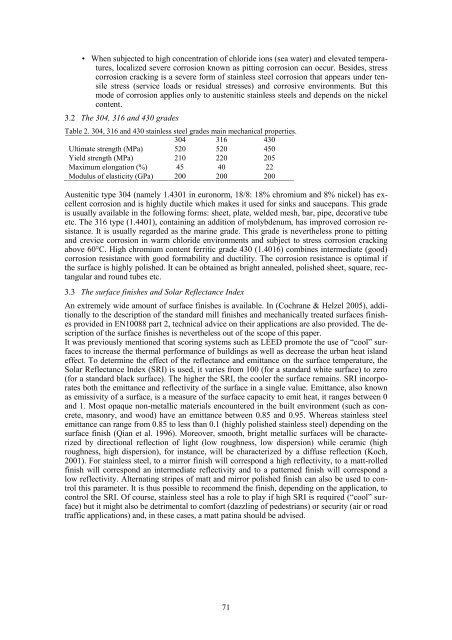
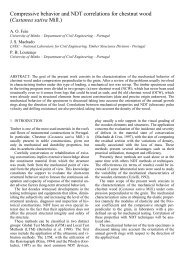
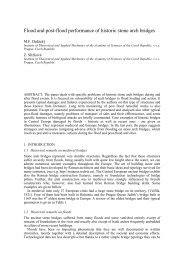
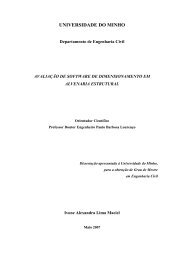
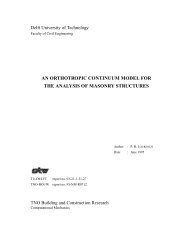

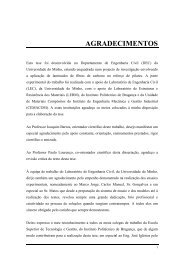

![Weibull [Compatibility Mode]](https://img.yumpu.com/48296360/1/190x134/weibull-compatibility-mode.jpg?quality=85)
